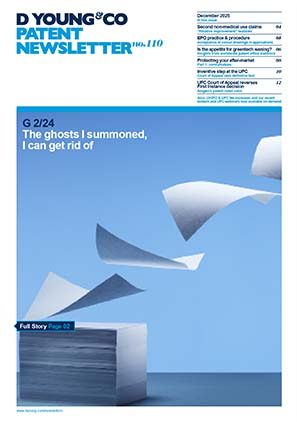Medtech: patent protection for custom medical devices
In the world of medical devices, finding a best fitting device for each patient has been a significant challenge for many years. Mass-produced devices, whether implants (such as joint sections used to treat arthritis and plates used to patch and join broken or missing bones) or removable appliances (such as ankle splints and knee braces) operate on the basis of manufacturing a small number of sizes. The medical professional then has to select (or event adapt) the standard device that best suits a particular patient.
All this has changed with advances in additive manufacturing techniques and materials. Where once a surgeon would have to cut and bend a standard metal skull patch plate to size and shape during surgery, now the patient can be scanned in advance and a plate that matches the shape of the skull can be manufactured specifically. This has huge benefits for both the patient and surgeon as the surgical procedure can be reduced by several hours, with the patient requiring much less time anaesthetised and the surgeon less exhausted from the effort of a long surgical procedure. However, effectively protecting a one-off custom produced implant of this type is not so straightforward.
Patents: protecting medical devices
Patents are used to protect new and useful processes, products or materials. But importantly, claims of patents in Europe cannot be directed to methods of medical treatment (other than in relation to specific medical uses of particular substances or compositions). This restriction is based in the concept that a medical practitioner should never be seen as infringing a patent when carrying out treatment to a patient. There is however no restriction on obtaining a patent on a device that may be used in a treatment method.
This situation has led to a long and valuable tradition of directing claims to the device that is used in the treatment method. Such devices may take many forms, with patents having been granted over many years for surgical tools, drug delivery devices, control systems for application of physical therapies, thermal pads and the like. For implants and appliances, the same is true, with patents traditionally being directed to the shape, structure and dimensions of the device itself. For example the famous “Exeter Hip” implant as developed by NHS surgeon Professor Robin Ling and engineer Dr Clive Lee received patents back in the 1980s for a design that remains largely unchanged to the present day (and which is still used in many hip replacement operations). However, in the case of custom medical devices as discussed above, the device is different every time, and so a patent to the device itself may struggle to protect all versions of the device that may be produced, and thus be of questionable commercial value.
Production of custom medical devices
A custom medical device is, in the present context, a device that is produced specifically for a particular patient based upon measurement of the patient. In most cases, this involves a digital manufacturing system, or at least the use of additive manufacturing to create the custom part.
Digital manufacturing systems (which are part of the so-called 4th industrial revolution) utilise an end-to-end view of the supply chain, with products being designed specifically for both a product need and a manufacturing process, with iterative optimisations fed into the design from both perspectives. These techniques are especially powerful when the manufacturing methodology uses additive manufacturing, as the traditional costs of tooling and prototyping associated with mass production are avoided.
Protecting a changing product
This is important from a patent protection perspective, as the design process, including how the design is specifically adapted to the particular manufacturing technique, can lead to patentable advances which enable commercially useful patent protection for a product which is never the same twice.
Of course, some such custom medical devices will all embody the same fundamental operational properties across all product instances that are created. However, this is not always the case, and as an additional consideration some medical devices have to be protected based upon shape or dimensions rather than operational property. Many applicants will be familiar with the European Patent Office's “result to be achieved” objection, which can force protection to be defined in a way that is based more on form than on function. These factors can mean that claims to operational property alone may not always be successfully achieved.
Thus it is important to consider, for all digital manufacturing systems but especially when creating a design and production system for custom medical devices, the end-to-end system that designs, creates and refines the ability to create one-off custom devices that are all the same “product”. While European patent protection may be available for the device itself, this is unlikely to be true for a device whose dimensions and structures change with each manufacture. Sometimes it may be possible to obtain a claim to a medical device that is defined in terms of its manufacture, but it is rare in Europe to be able to secure patent claims for a device that is defined by a method of manufacture unless the manufacture causes specific unique properties in the product.
Therefore, for custom medical devices produced using a digital manufacturing systems approach there is likely to be significant IP value in looking to the manufacture process which provides the device with its fundamental properties. Thus for European patent applications in this area, it may be appropriate (in addition to seeking purely functional protection and device manufacture protection) to also seek protection for the underlying methodologies which are used to create the custom medical device. This may provide a useful route to achieving protection for the product which is directly obtained from that method of manufacture, and thus avoid difficulties of trying to protect the ever-changing product itself.

